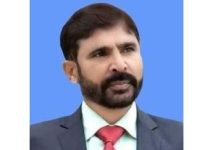Muhammad Wali Jan
The breakdown of Bashar al-Assad’s regime in Syria marks a pivotal moment in Middle Eastern geopolitics, reshaping the balance of power and highlighting vulnerabilities in key regional and global alliances. Described by Middle East expert Dr. James Dorsey in his interview as a “tectonic shift,” the regime’s collapse has exposed the brittle nature of Assad’s military, which faltered rapidly to recent rebel offensives in key cities such as Hama, Homs, and Aleppo. This unexpected disintegration shows the internal fragility of the Syrian state, exacerbated by years of Economic stagnation, war fatigue, and dwindling popular support.As the Assad regime fell, the focus turned to the broader implications for regional stability. Syria’s Future ruling framework remains uncertain, with rebel factions facing the challenge of navigating ethnic and sectarian divides. Despite the chaos, the recent offensives were notably free of widespread violence against minority groups, signaling a potential shift toward Holistic political solutions for post-conflict stability. However, the absence of a unified vision among the opposition threatens to prolong instability, complicating efforts to establish a harmonious government.For Iran, the fall of Assad implies a major strategic loss. Syria has long served as a backbone of Iran’s regional influence, providing a vital land route for supplying arms to Hezbollah in Lebanon. With this lifeline severed, Iran’s forward defense strategy faces significant disruption, leaving Iran more relying on its ballistic missile program and nuclear capabilities. Hezbollah, already weakened by years of involvement in the prolonged Syrian conflict, now faces further challenges as its supply chains are cut off. The loss of Syria as a reliable ally weakens Iran’s ability to project power in the Levant region, forcing the reconsideration of its partnerships with non-state actors and its broader regional strategy.Russia, another key actor in the Syrian Conflict, also faces a significant Strategic setback. Despite its significant military funding and direct support for Assad’s regime, Moscow’s Incapability to prevent the regime’s collapse exposed the limitations of its influence in the region. Dr. Dorsey resembled the situation to the U.S. withdrawal from Saigon in 1975,suggesting that a Russian retreat from Syria would symbolize significant damage to reputation. The reliance on local Syrian forces, which lacked the resolve to sustain prolonged resistance, further exposes the vulnerability of Russia’s standing in the Middle East. While speculation about Ukrainian involvement in helping the rebels remains unconfirmed, the collapse not only complicates Russia’s broader interest in the region, particularly as it juggles ongoing challenges in Ukraine.Türkiye stands poised to play a key role in shaping Syria’s post-Assad dynamics. Positioned as a potential player, Ankara may use its influence to support the Creation of an Islamist-leaning government in Damascus, aligning with its regional interest. But this strategy comes with risks, particularly concerning tensions with Kurdish groups and decentralized rebel factions like Hayat Tahrir al-Sham. Balancing these competing interests will test Türkiye’s ability to address the complexities of Syria’s fractured political dynamics.As for the United States, the downfall of Assad presents both challenges and opportunities. Washington’s primary focus has been on counterterrorism and containing the Islamic State, but Assad’s fall may provoke a reassessment of its broader strategy in Syria. Dr. Dorsey highlighted the uncertainty surrounding U.S. policy, especially under the upcoming government, which has sent ambiguous signals on its approach to the conflict. The potential for a more disintegrated Syria raises concerns about the resurgence of jihadist groups, which may adapt their strategies to exploit the vacuum left by Assad’s collapse.The ripple effects of Assad’s collapse reach beyond Syria, influencing the strategic calculations of regional powers, global jihadist factions, and international stakeholders. While the accelerated breakdown of the regime has exposed weaknesses in long-standing alliances, it also offers a ray of hope for a more inclusive political future in Syria. However, realizing this potential will require navigating deep-seated divisions and managing competing interests both within Syria and among external actors, making the road to stability as uncertain as ever.
Muhammad Wali Jan
Student of International Relations at NUML Islamabad












